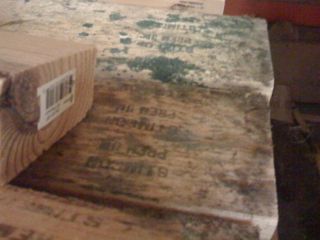Asthma and Poor Indoor Air Quality — The Trouble with Homes

I grew up with really bad asthma. Not being able to get enough air into your lungs, in case you haven’t experienced it, is pretty scary. I remember lying in bed during one asthma attack, gasping for air, wheezing loudly, and feeling like I was going to die. A trip to the hospital for a shot opened up my lungs again that night, but I continued to suffer asthma attacks even into my mid-twenties. I’m one of the lucky ones who managed to ‘outgrow’ this debilitating disease, but many live with it every day.
Asthma is often triggered by environmental conditions, and two of the triggers I had to avoid were live Christmas trees and feather pillows. To protect me from the former, my parents got one of those silvery aluminum Christmas trees that are all the rage on ebay now. I also slept mostly on foam pillows, but one night as a teenager, I made the mistake of not telling my friend Guy that I was allergic to feather pillows. Four decades later, he still has vivid memories of his fear that I was going to die that night.
Asthma is bad. Very bad.
The reason I’m writing  about it here is that I just read a great article called The Trouble with Building Science from the Fine Homebuilding website. It’s fairly general but does focus on moisture management, or the lack thereof, in homes. If you’ve been a reader here for a while, you know that I discuss that issue, too, and just last week wrote an elementary demystification of vapor retarders.
about it here is that I just read a great article called The Trouble with Building Science from the Fine Homebuilding website. It’s fairly general but does focus on moisture management, or the lack thereof, in homes. If you’ve been a reader here for a while, you know that I discuss that issue, too, and just last week wrote an elementary demystification of vapor retarders.
Here’s the paragraph in the Fine Homebuilding article that spurred my post today:
In the past, experts argued about whether mold posed a serious health threat, but according to a 2007 study funded by the EPA, “Of the 21.8 million people reported to have asthma in the U.S., approximately 4.6 million cases are estimated to be attributable to dampness and mold exposure in the home.” The same study goes on to say, “The national annual cost of asthma that is attributable to dampness and mold exposure in the home is estimated to be $3.5 billion.” Those are just health costs; they don’t include mold remediation. The authors also estimate that dampness or mold is present in 47% of homes.
As a former asthma sufferer, I find those numbers appalling. By not paying attention to the details of moisture management, we’re hurting indoor air quality and people — nearly 5 million of us!
Why is there so much dampness and so much mold growing in so many homes? As architect and building scientist Bill Rose points out in the article, the main source is rain. It comes in through the top, the sides, and the bottom. Plumbing leaks also pose a sigificant risk, and that’s what’s going on in the photo at the top of this article. Water vapor, according to the FH article is third in importance.
One they didn’t mention in the article is building materials that are wet and moldy when installed. And here’s a little secret about that one. If your house was built in 2009 or 2010, it may be more susceptible to that problem.

I took the photo above at a building supply store in May 2009. That whole stack of 2x4s was moldy like this. Why? Recall what happened in 2008. That’s when the economy took a nosedive, and construction went off a cliff. The suppliers couldn’t reduce their production as quickly as demand went down because, being so large, they had a lot of inertia. The lumber was still flying out of the mill but not being loaded onto trucks and delivered to the lumberyards. It sat out longer than usual, getting wet and then starting to grow the kind of stuff you see above. I have no idea how much moldy lumber got put into new homes that people are now living in, but I do know that it was getting delivered.
It’s time for the construction industry to get serious about moisture management. If everyone responsible for building homes got to experience the feeling of a bad asthma attack, maybe it would happen more quickly.
Allison A. Bailes III, PhD is a speaker, writer, building science consultant, and the founder of Energy Vanguard in Decatur, Georgia. He has a doctorate in physics and writes the Energy Vanguard Blog. He also has a book on building science coming out in the summer of 2022. You can follow him on Twitter at @EnergyVanguard.
Related Articles
Vapor Retarder? Vapor Barrier? Perms? What the Heck?!
Looking at the Building Science Issues in an Old, Humid Basement
Comments are closed.
This Post Has 7 Comments
Comments are closed.

Allison your timing is
Allison your timing is impeccable.
This just published, “Gutarowska, B., et al, An Investigation of Allergenic Proteins Produced by Moulds on Building Materials, Indoor and Built Environment 2012;21 253-263”
http://tinyurl.com/d3v45gu
When it comes to asthma and its potential to harm, I know of what you speak.
Another source of moistur and
Another source of moistur and mold is high speed air movement through an AC coil. A face velocity of more than 500 ft/min will strip water from the AC coil and down the ductwork. One of the really big contributors is the ridiculous bypass duct that relieves pressure in a zoned forced air system.
In the first case, you can reduce the indoor humidity by maodulating the blowers speed by keying it to the delivered air temperature. 10% RH reduction is common. For zoned systems, our ecMModulator modulates the blower’s speed up to a set (adjustable) pressure. All the air through the coil is return air. The system’s average air speed is quite a bit lower which allows all IAQ products to work at a much higher efficiency.
Modulating the blower speed
Modulating the blower speed to keep a constant coil temperature is idea, but expensive and therefore impractical for most homes. A much simpler answer is to use a humidistat to switch the blower speed in cooling mode. For $50 in parts this can be implemented on a standard PSC system, no complete HVAC system required.
http://www.fluke.com/Fluke/usen/community/fluke-news-plus/ArticleCategories/HVAC/Battling+High+Humidity.htm
Interesting comments. In 1984
Interesting comments. In 1984 I was working on a lowrise building in Edmonton that had been built during the boom days. The cedar siding used had not been kiln dried and one of the tenants was constantly in the hospital with Bronchial problems due the mold on the partcle board walls behind the siding. As the siding dried it shrunkl, cracked and knotholes popped out allowing water entry into the wall assembly.As an asthmatic it takes less than 5 minutes for me to react with residences with mold issues.
Jim Jennings
C.E.O.
Canadian Academy of Building Sciences Inc.
Great article!
Great article!
@Peter, in large fabricated
@Peter, in large fabricated commercial HVAC systems, coil temperature is often monitored and factored into fan and capacity controls. However, This is more about dynamic latent capacity control than to prevent coil blow-off.
Coil blow-off is only an issue at very high face velocities, and frankly is not much of an issue in residential. For example, my Lennox 3 ton air handler DX coil has a surface area of 5 ft2. Even at 500 CFM per ton (rare in residential), you’re still only talking about 300 FPM face velocity (3 * 500 = 1500, 1500 / 5 = 300). A residential system would have to be very poorly designed and matched in order for coil blow off to be a problem.
Thanks for all the great
Thanks for all the great comments. I was hoping maybe someone would add something to what I said about moldy wood at the lumber yards in 2009. Anyone got any info on that?